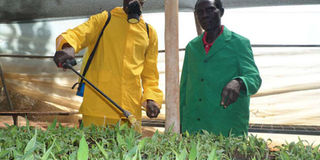Locals get training on tissue banana farming

Naboth Monde, Wongachi Development farm manager(right) and worker spraying the Tissue culture banana seedlings. The greenhouse has 100000 seedlings. PHOTO |FILES
What you need to know:
- Most banana farmers in the region have embraced the technology but still end up with poor yields
- Tissue culture involves multiplying clean disease-free planting materials without changing the taste or other physical attributes of the plant.
Locals get training on tissue banana farming
Farmers who visit Kisii Agriculture Training Centre are eager to get information on tissue culture banana production.
Most banana farmers in the region have embraced the technology but still end up with poor yields.
Tissue culture involves multiplying clean disease-free planting materials without changing the taste or other physical attributes of the plant.
While assessing farmers being trained on growing tissue culture banana, Kisii County agriculture director Benson Mutiso said marketing of the crops begins with at production and not harvesting stage as most farmers think.
“Producing tissue culture bananas is a challenge. Most of the crops end up dying in the first month,” the county agriculture official said.”
Mr Mutiso advised farmers to get clean seedlings from certified suppliers only.
“Farmers should also avoid using fields that already have bananas as this helps keep away pests and diseases,” he said.
—Ruth Mbula
Forests are critical to farming, report shows
At a time the government has extended the ban on logging, a recent report by the Food and Agricultural Organisation says forests are critical to livelihoods and sustainable farming.
According to The State of World’s Forests, research has shown that ending poverty and hunger can be done through the coordination of policies by the ministries of Agriculture and Environment.
The authors of the report say it is important for governments and concerned organs to address agriculture and forests together for sustainable development, especially in rural areas.
“Deforestation, chiefly caused by the conversion of forestland to agriculture and livestock areas, threatens the livelihoods of foresters, forest communities, indigenous peoples and the variety of life on the planet,” the report says.
According to FAO, changes in land use result in loss of habitats, land degradation and soil erosion, the factors largely blamed for reduced food production, especially in developing countries.
“How to increase agricultural production and improve food security without reducing forest area is one of the great challenges of our times. Evidence is key to opening up forest pathways to sustainable development,” the report says.
—Bernadine Mutanu
New innovations picked to drive food security in the Lake Region
Over 100 food security enhancing technologies developed by youths from the 14 Lake region economic bloc counties have been selected for acceleration.
Panelists for The IREN Technologies and Innovation Challenge 2018 (ITIC-2018) have selected 165 innovators to undergo an accelerator training that will help them develop and showcase smart food security technologies and innovations to a wider market.
The training commenced in June in the respective counties and will run through to October 2018.
The successful youths from Bomet, Bungoma, Busia, Homa Bay, Kakamega, Kericho, Kisii, Kisumu, Migori, Nyamira, Nandi, Siaya, Trans Nzoia and Vihiga have joined their respective County Technology & Innovation Solution Hubs to conceptualize, develop and pitch their smart food security solutions.
The best hub from each county will compete with fellow top hubs for top three spots. The top three overall winners stand a chance to win seed capital to scale up their innovations.
The ITIC 2018, an initiative of Inter Region Economic Network and the Friedrich Naumann Foundation, aims to promote smart food security solutions for the 14 Lake Region Economic Bloc Counties.
Veni Swai, Senior Programme Officer for Friedrich Naumann Foundation, East Africa says that fiinding innovative solutions to food security challenges facing the Lake Region Economic Bloc counties is very critical.
—Leopold Obi
Invest more in livestock disease surveillance, government urged
Veterinary service regulatory body has urged the county and national governments to invest more in disease surveillance and control to curb the spread of contagious livestock diseases such as the Rift Valley Fever.
Rift valley fever outbreak which was first reported in Eldas Sub-County, in Wajir, is suspected to have spread to six other counties including Tharaka-Nithi, Garissa, Tana River, Lamu, Garissa, Kajiado and Baringo.
The disease mainly affects livestock but people can be infected by handling sick animals – either slaughtering them or assisting animals while giving birth.
Kenya Veterinary board chairman Dr Christopher Wanga says that while the response to curb the viral disease has been initially slow when it was reported a few months ago, livestock in the affected areas must be quarantined to curb the spread of the disease.
Dr Wanga also urged the governments to employ more qualified vet officers to protect members of the public from quacks posing as doctors.
He further cautioned politicians opposed to livestock quarantine saying that viral diseases are only controlled through vaccination and quarantine.
“We should have carried out vaccinations during flooding because floods are usually followed by Rift Valley Fever. So we are a little late in intervening but the counties and the director of vet have moved in to contain the disease,” Dr Wanga explained.
The Kenya Vet Board chair also urged the national and county governments need to provide emergency response fund in their budget and also promote disease control and management.
“About 80 per cent of the country is arid or semi-arid meaning that without irrigation, livestock rearing is the only enterprise which can be carried in those areas. The government therefore needs boost disease surveillance and employ more vet officers,” noted Dr Wanga.
— Leopold Obi





